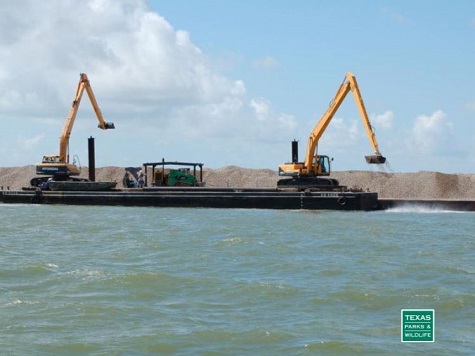Texas Parks & Wildlife Department (TPWD) announced a project this week to rebuild vital oyster reefs by distributing more than 79,000 cubic yards of reef building materials (known as cultch) at eight different sites in four publicly owned oyster reefs in Galveston Bay and Sabine Lake. The effort, to be complete by August, will represent a record-breaking effort by TPWD in restoring and expanding the reefs in these regions.
In an interview with Breitbart Texas, Oyster Restoration Specialist Bill Rodney explained TPWD has demonstrated great success with these types of projects in the past. The current project will complete the restoration of 205 acres of new oyster reefs that will eventually be open to commercial harvesting but which also provide great ecological benefit to the regions. Rodney explained the effort will help replenish the oyster population in areas that were damaged by hurricanes, reduced freshwater inflows, hydrologic alterations, diseases, predators and heavy commercial fishing, along with other human related stressors.
The oyster reefs selected for this project include Middle Reef, Pepper Grove Reef and Hannah’s Reef in Galveston’s East Bay and the large Sabine Reef in Sabine Lake. Rodney said the Pepper Grove Reef oysters “were recently named as some of the tastiest oysters by Thrilllist.com.” Only two of the top fifteen oysters come from the Gulf of Mexico.
Rodney explained this project will use “unseeded” cultch materials in the restoration. The cultch material is made up largely of river rock and limestone. “We have had a lot of success in the past by using this technique,” Rodney explained. He said the oyster larva from the nearby existing reefs will find the expanded areas and populate them quickly. This method allows for the same species of oysters to grown in their natural environment.
“The oysters mature to harvesting size in about eighteen months to two years,” Rodney stated. “Because of this, these reefs will be closed to commercial fishing for two years.” The Sabine Lake reef is located in waters that are permanently closed to commercial oyster harvest due to pollution concerns.
The project is estimated to cost around $4.7 million and is being funded by a grant to the TPWD by the Coastal Impact Assessment Program. This program allows the federal government to distribute fees collected from offshore oil and gas leases. Additional project funding was provided by Coastal Conservation Association Texas, The National Fish and Wildlife Foundation, and the NFWF Gulf Environmental Benefit Fund. Some of these funds came indirectly from the BP oilfield incident. Rodney told Breitbart Texas that none of the reefs in this project were affected by the March Galveston Bay oil spill. “This program has been in the planning states for a couple of years now,” Rodney said.
One of the primary functions of these oyster reefs it to provide filtration for the local ecological system. According to a TPWD press release, Oysters feed by filtering tiny plants known as phytoplankton from the water, with a single oyster capable of filtering up to 50 gallons a day. This filter feeding also removes silt and contaminants from the water, making oyster reefs natural bio-filters. Oyster reefs also provide habitat for numerous bottom-dwelling fish and invertebrates. These, in turn, are food for larger game fish, a food chain that benefits commercial and recreational activities.
Rodney explained these reefs, while not as colorful as the coral reefs, are just as interesting to watch. “These reefs have their own species of Goby and Skillet fish that live in with the oysters,” he explained. “Unfortunately, they have kind of a PR problem. Because of the murky conditions that surround the reefs, it is hard to observe and photograph this ecosystem in action.”
Prior to this year’s oyster restoration work, TPWD restored 30 acres on Dollar Reef, Galveston Bay, in 2013; 175 acres on six Galveston Bay reefs in 2011; five acres off San Leon, Galveston Bay, in 2009-2010, and 20 acres on Middle Reef in East Bay in 2009.
Visit the Texas Parks and Wildlife website for more information about this project and for contact information.
Follow Bob Price on Twitter @BobPriceBBTX

COMMENTS
Please let us know if you're having issues with commenting.